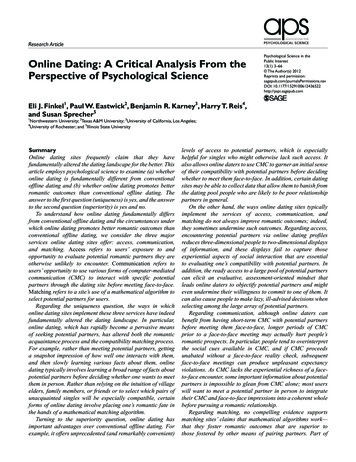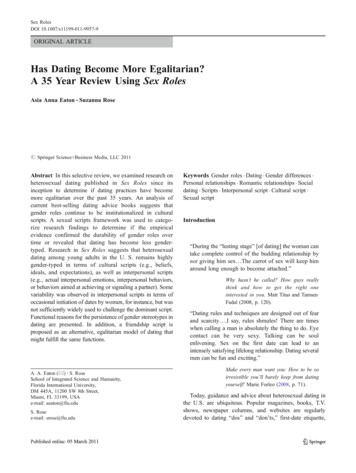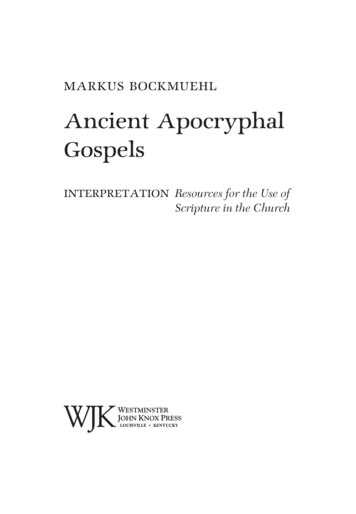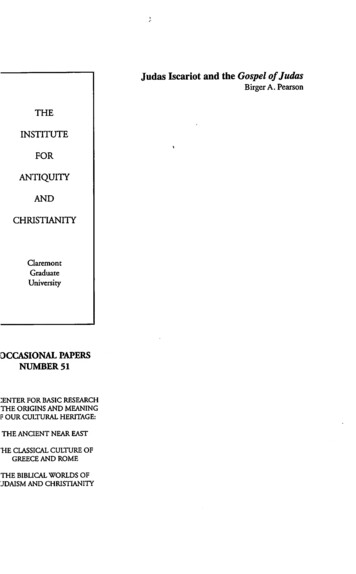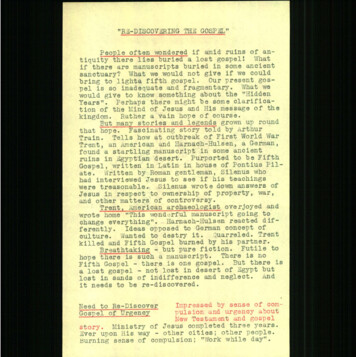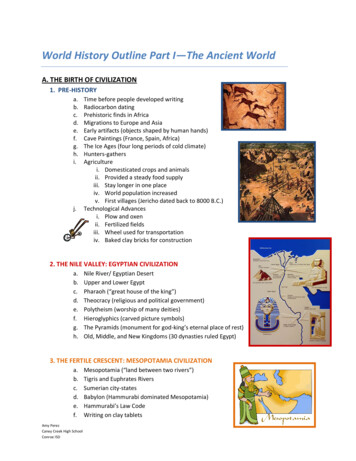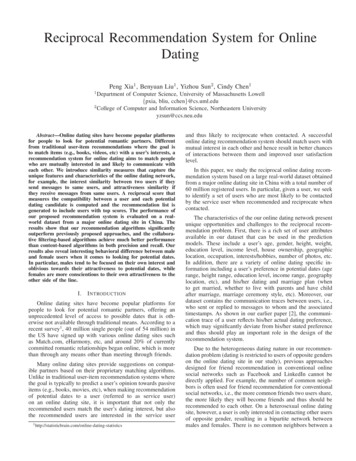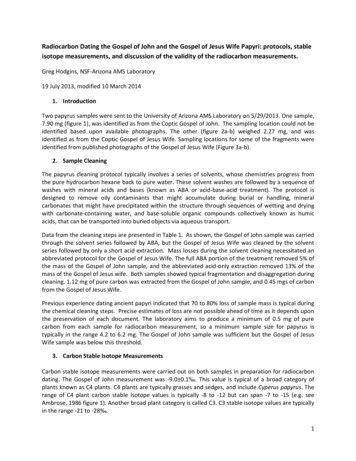
Transcription
Radiocarbon Dating the Gospel of John and the Gospel of Jesus Wife Papyri: protocols, stableisotope measurements, and discussion of the validity of the radiocarbon measurements.Greg Hodgins, NSF-Arizona AMS Laboratory19 July 2013, modified 10 March 20141. IntroductionTwo papyrus samples were sent to the University of Arizona AMS Laboratory on 5/29/2013. One sample,7.90 mg (figure 1), was identified as from the Coptic Gospel of John. The sampling location could not beidentified based upon available photographs. The other (figure 2a-b) weighed 2.27 mg, and wasidentified as from the Coptic Gospel of Jesus Wife. Sampling locations for some of the fragments wereidentified from published photographs of the Gospel of Jesus Wife (Figure 3a-b).2. Sample CleaningThe papyrus cleaning protocol typically involves a series of solvents, whose chemistries progress fromthe pure hydrocarbon hexane back to pure water. These solvent washes are followed by a sequence ofwashes with mineral acids and bases (known as ABA or acid-base-acid treatment). The protocol isdesigned to remove oily contaminants that might accumulate during burial or handling, mineralcarbonates that might have precipitated within the structure through sequences of wetting and dryingwith carbonate-containing water, and base-soluble organic compounds collectively known as humicacids, that can be transported into buried objects via aqueous transport.Data from the cleaning steps are presented in Table 1. As shown, the Gospel of John sample was carriedthrough the solvent series followed by ABA, but the Gospel of Jesus Wife was cleaned by the solventseries followed by only a short acid extraction. Mass losses during the solvent cleaning necessitated anabbreviated protocol for the Gospel of Jesus Wife. The full ABA portion of the treatment removed 5% ofthe mass of the Gospel of John sample, and the abbreviated acid-only extraction removed 13% of themass of the Gospel of Jesus wife. Both samples showed typical fragmentation and disaggregation duringcleaning. 1.12 mg of pure carbon was extracted from the Gospel of John sample, and 0.45 mgs of carbonfrom the Gospel of Jesus Wife.Previous experience dating ancient papyri indicated that 70 to 80% loss of sample mass is typical duringthe chemical cleaning steps. Precise estimates of loss are not possible ahead of time as it depends uponthe preservation of each document. The laboratory aims to produce a minimum of 0.5 mg of purecarbon from each sample for radiocarbon measurement, so a minimum sample size for papyrus istypically in the range 4.2 to 6.2 mg. The Gospel of John sample was sufficient but the Gospel of JesusWife sample was below this threshold.3. Carbon Stable Isotope MeasurementsCarbon stable isotope measurements were carried out on both samples in preparation for radiocarbondating. The Gospel of John measurement was -9.0 0.1‰. This value is typical of a broad category ofplants known as C4 plants. C4 plants are typically grasses and sedges, and include Cyperus papyrus. Therange of C4 plant carbon stable isotope values is typically -8 to -12 but can span -7 to -15 (e.g. seeAmbrose, 1986 figure 1). Another broad plant category is called C3. C3 stable isotope values are typicallyin the range -21 to -28‰.1
The Gospel of Jesus Wife measurement was -14.3 0.1‰. This value is within the total range of C4 plantsbut low compared to values derived from other papyrus documents dated in this laboratory. Canvasingother AMS laboratories for papyrus carbon stable isotope measurements bore this observation out.Table 2 shows that the Gospel of Jesus Wife δ13C value was the lowest of 42 documented old andancient papyri measurements.4. Radiocarbon MeasurementsRadiocarbon measurements were carried out by accelerator mass spectrometry. This instrumentquantifies the amount of radiocarbon (14C) in a sample relative to its carbon stable isotope content (13Cor 12C). This ratio is compared to the same ratio within modern standard materials and the resultexpressed as the Fraction Modern, or FM. Small differences in radiocarbon content between samples ofthe same age are accounted for based upon differences encountered in stable isotope content. Thisprocess is known as isotope fractionation correction.The isotope fractionation corrected radiocarbon measurement of the Gospel of John fragment was0.8568 0.0033 Fraction Modern. The Gospel of Jesus Wife radiocarbon measurement was0.7526 0.0035 Fraction modern.The radiocarbon content of a sample is translated into a calendar date range by the process ofcalibration. It is accomplished using a dataset comprised of a large number of radiocarbonmeasurements on known-age samples. Throughout the Holocene, the calibration samples are knownage tree rings. The Gospel of John measurement was calibrated to the range of 681 to 781 CalAD, and787 to 877 CalAD at 95.4% confidence (figure 4). The Gospel of Jesus Wife measurement generatedcalibrated date ranges of 405 to 350 CalBC and 307 to 209 CalBC at 95.4% Confidence (figure 5).5. Discussion and ConclusionThe reliability of the Gospel of Jesus Wife radiocarbon measurement is questionable. Three things are atplay in the assessment of the current measurement: 1, the abbreviated cleaning protocol; 2, the oddcarbon stable isotope measurement; and 3, the early GJW papyrus radiocarbon date.The abbreviated cleaning protocol might be significant. The stable isotope measurement and the earlydate might be explained by the presence of a contaminant that was not completely removed duringcleaning. For example, a brownish residue was visible on one of the GJW fragments submitted formeasurement (figure 3). This might be original to the papyrus (for example, see Wiedemann and Bayer1983), or a later addition. Contaminating carbon might also have been introduced in the recent past aspart of a treatment to preserve the piece, or in this laboratory, for example, in the form of traces oforganic solvent not completely removed in the abbreviated cleaning protocol. The presence of acontaminant, either a natural product or a modern petroleum-derived synthetic material, could alter thecarbon stable isotope value and the measured radiocarbon age. This could result in either anerroneously old or an erroneously young date.The carbon stable isotope value of the GJW (-14.3 ‰) is odd. Although modern living papyri havedocumented stable isotope values in this range (Gichuki et al. 2005), their relevance to the ancientwriting media is debatable. A survey of carbon stable isotope measurements from other papyrusdocument dating projects suggests that a range of heavier values is typical (Table 2). The odd measured2
value is strong evidence for the presence of a contaminant on the GJW sample. If this is the case, thecontaminant has a low carbon stable isotope value.The measured Gospel of Jesus Wife radiocarbon date is strange but not impossible. However, if acontaminant was present in the measured sample, and the true age of the papyrus is in fact younger, itwould suggest that the contaminant is radiocarbon depleted. Further sampling of the document andadditional measurements would be required to sort this out.6. ReferencesAmbrose, S. (1986) Stable carbon and nitrogen isotope analysis of human and animal diet in Africa.Journal of Human Evolution 15:707-731.Gichuki, J. W., Triest, L., Dehairs, F. (2005) The fate of organic matter in a papyrus (Cyperus papyrus L.)dominated tropical wetland ecosystem in Nyanza Gulf (Lake Victoria, Kenya) inferred from δ13C and δ15Nanalysis. Isotopes and Environmental Health Studies 41(4):379-390.Wiedemann, H. G., Bayer, G. (1983) Papyrus: the paper of ancient Egypt. Analytical Chemistry55(12):1220A-1230A.3
7. TablesTable 1: Summary of Chemical Pretreatment protocols and sample recovery data.Papyrus Sample PretreatmentsLab number:AA101793AA101794Protocol/DataGospel of JohnJWG7.902.27Soxhlet extraction hexane6.5 hrs6.5 hrsEthanol11 hrs11 hrsMethanol8 hrs8 hrsType 1 dH2O washes (4x)2 hrs2 hrsMass after Freeze Drying (mg)3.491.444463ABA, 1.0 N HCl16 hrs RT30 min RT0.1 N NaOH2 hrs RTnot done0.1N HCl1 hr RTnot doneType 1 dH2O washes (4x)2 hrs2 hrsMass after Freeze Drying (mg)3.071.143950Combusted mass (mg)2.441.14Carbon recovered (mg)1.120.45% carbon recovery45.939.5Starting Mass after Freeze Drying (mg)mass % recovery% recovery4
Table 2: Comparison of δ13C measurements from papyrus documents and specimens from the Oxford,VERA, LABEC, CIRCE and Arizona AMS Laboratories.δ13 CLab RefOriginDynastic Period or NameSample IDDateErrorOxA-15313IllahunSenusret III10009350330-9.4VERA-3726IllahunSenusret III10009354329-11.0OxA-15315IllahunSenusret III10041351331-8.9VERA-3728IllahunSenusret III10041356529-11.3VERA-3735IllahunAmenemhet III10044355029-10.8OxA-15316IllahunAmenemhet III10053354230-9.3VERA-3729IllahunAmenemhet III10053356329-10.8VERA-3732IllahunSenusret III10077356329-9.6VERA-3733IllahunAmenemhet III10091356828-7.8OxA-15317IllahunSenusret III10092353231-8.7VERA-3730IllahunSenusret III10092352929-10.2OxA-15311IllahunSenusret III10248353231-9.4OxA-15310IllahunAmenemhet III10018Bd356033-8.9OxA-15314IllahunAmenemhet III10038 b c375533-10.1VERA-3727IllahunAmenemhet III10038 b c352229-10.0VERA-3734IllahunAmenemhet III10038a351229-9.0OxA-15309IllahunAmenemhet III10081c362633-9.7OxA-15318IllahunSenusret III10345d351831-9.2VERA-3731IllahunSenusret III10345d351329-11.5OxA-15312IllahunAmenemhet III10419a348531-8.8OxA-14993IllahunSenusret IIFragment B2355132-9.4OxA-14994IllahunSenusret IIFragment B2348332-9.0OxA-18052SaqqaraDjoserMMA 1131-9.1OxA-16838ThebesAmenemhat I or Senusret IMMA 22.3.5239362032-9.8VERA-4075ThebesAmenemhat I or Senusret IMMA 22.3.5239367929-11OxA-20189ThebesRamesses IVBM9999/97297227-9.1OxA-20213ThebesRamesses IX-XIBM10326277128-10.8OxA-20214ThebesRamesses dorus PapyrusArte 1197480-11.5LABEC/CIRCEAlexandria?Artimedorus PapyrusArte 2190667-11.5LABEC/CIRCEAlexandria?Artimedorus PapyrusArte 3195833-11.5OxA-16346Nile River BankC. alopucuroides Rottb.2a 114127-9.0OxA-16342AlexandriaC. dives Del.25a 111226-8.3OxA-16344AlexandriaC. longus L.27 112627-8.2AA-62452unknownCodex Chacopage 9173948-10.0AA-62453unknownCodex Chacopage 39172647-9.9AA85363MemphisEarly 18th Dyn., Book of the Dead#371777E324942-9.3AA99528Medinet MadiManichaean Codexcartonnage157238-10.0AA101793unknownGospel of John Copticfragment124231-9.2AA101794unknownGospel of Jesus Wifefragment228337-14.31. botanical specimenOxA and VERA data graciously provided by Michael Dee, University of Oxford, and Ezra Marcus, University of Haifa,previously published in Bronk Ramsey C et al. (2010) Science 328:1554-1557 and Dee M et al. (2010) J Arch Sci 37:687-693.LABEC/CIRCE data courtesy Marialena Fedi, dates previously published in Fedi M et al. (2009) Radiocarbon 52(2):356-363.AA85363 data courtesy Paul O'Rourke and Edward Bleiberg, Brooklyn Museum. AA99528 data courtesy Jason BeDuhn,Northern Arizona University. Other AA data courtesy Greg Hodgins and Tim Jull, University of Arizona.5
8. FiguresmmFigure 1: Gospel of John samples photographed at AMS Laboratory. Photo: G Hodgins 5/31/20136
mmFigure 2: Gospel of Jesus Wife samples received at AMS Lab: normal (l) and raking (r) light. Note possible residueon bottom center fragment. Photos: G. Hodgins 5/31/2013Figure 3: Identifying fragment locations from web site photographs of GJW, back (l) and front du/files/images/papyrus back lg.jpg, accessed vard.edu/files/images/papyrus front lg.jpg, accessed 5/31/2013.7
Figure 4: calibration plot for Gospel of John radiocarbon measurementFigure 5: calibration plot for the Gospel of Jesus Wife radiocarbon measurement8
the mass of the Gospel of John sample, and the abbreviated acid-only extraction removed 13% of the mass of the Gospel of Jesus wife. Both samples showed typical fragmentation and disaggregation during cleaning. 1.12 mg of pure carbon was extracted from the Gospel of John sample, and 0.45 mgs
